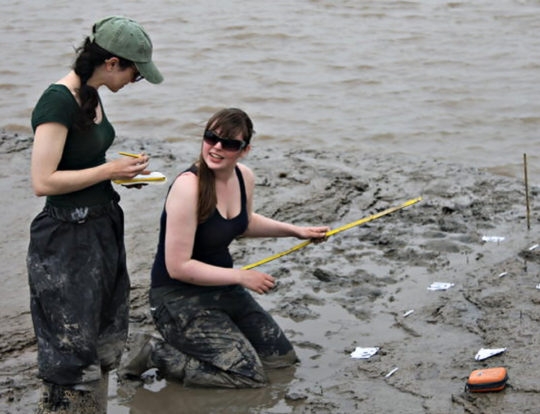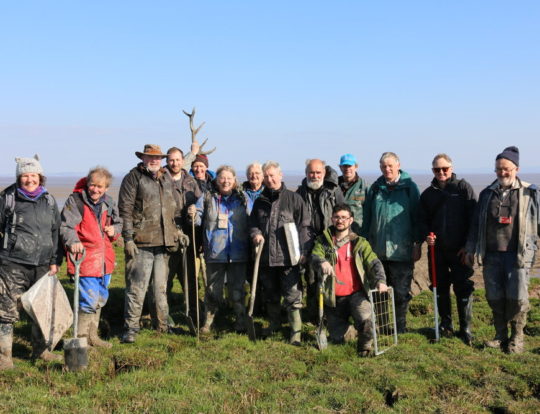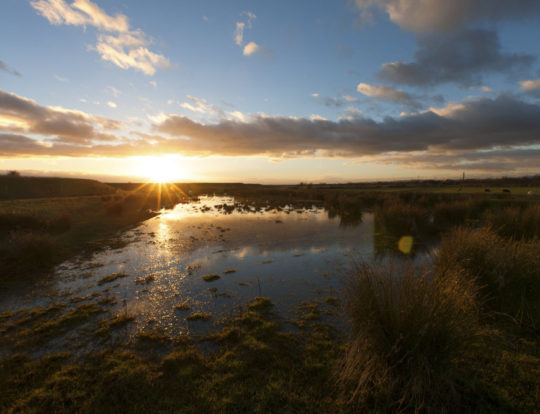When you first come to the page you will see the whole Living Levels area with all the points already mapped.

To add a new point you need add the information to the panel on the left. We will fill it in using this example from Sue Waters to show you what to do:
MOM: So what was Nash School like?
SW: Ooh, that was a lovely place, I have got such fond memories of it. We had three teachers… Miss Kyte, who was a sister to the Kytes that lived down at Porton, she was the Head Teacher. There was two Mrs Davies so we managed to call the one Miss Millard and she, Miss Millard taught the infants and Mrs Davies taught the next age group, so the infants would have gone from 5 to 8, and then we would have gone from 8 to 10 in Mrs Davies’ class, and from 10 … or to – you know, then when we would have moved on, in Miss Kyte’s class …. but, so – the large classroom was divided by a big red curtain, and then there was a stove in the centre … and as a child I always remember Miss Kyte leaning against the guard and pulling her skirt up at the back to warm herself. (laughs) But there was a fire grate in Miss Millard’s room, and always a fire in the grate through the winter months and a lady by the name of Mrs Water, who lived out Nash Arch, she used to keep the fires burning. and Mrs England as well. They are lovely, two lovely ladies – pillars of the community and we always remember about how when we got to school, it was wonderful, it was all warm.
MOM: Do you remember any playground games, or anything like that?
SW: Oh, it was mostly tag. Hopscotch was a big one, and we used to have skipping ropes so we’d all be skipping or you know – where you have the large rope. Yes, we were very imaginative because we played games all the time. All the children got on well – I don’t remember bullying I don’t remember people being unkind. There were nicknames – but you know – people didn’t take much notice.
MOM: Were most of the children from farming stock?
SW: I would suggest so. There were two playgrounds, one for the older children and one for the younger ones. Yes, they’d come from outlying farms and if you go back generations before me even, when Hubert Jones was writing about his childhood in Nash, they would walk miles across the fields, and he talks of David’s family who lived in Tatton Farm which is down the bottom end of the village and they had to come across at least three to four fields and then a mile further down to school and the Tatton family as we used to call them did that every morning and everybody up Broad Street Common would have to walk down to school so, yes, it would have been mostly families that were involved in agriculture they were farmers or farm labourers, it didn’t make any difference they all meet up on their journey to the school.
MOM: and presumably children walked on their own, without parents?
SW: I think from that particular area the children used to walk and meet each other depending on their age. I had a brother a year and a half older than me and as there was no pavement on the road between our house and the school, so I remember waiting for my friend Elizabeth Waters to walk up from Great House and the three of us would walk up holding hands together and, then you know, invariably somebody would catch you up from further down the road or whatever.
MOM: Did you learn Welsh at school?
SW: Oh gosh, no. It was never a Welsh speaking area. We were always classified as ‘Wales and Monmouthshire’ – and – Monmouthshire didn’t particularly speak Welsh – so, no, no. My mother was from the Welsh Valleys and I did, remember learning a few words from listening to her, and she would sing in Welsh to me. Always, always sang me lullabies and she taught me – so much about music. She played the piano and, I guess, yes, whenever she sang it was often in Welsh.
1. Select the interviewee name from the dropdown menu.

2. Paste in the short description of the audio clip.
3. Add the places named in the clip (separated by a comma).
4. Paste in the transcript (only the section spoken in the clip).
For all three of these steps you will only need to copy over the information you recorded on the table while listening to the interview.

5. Then to add the location line up the crosshairs in the centre of the map with the location. You do this by moving the map. The map reference will automatically populate when you press the red crosshair. This is the main location talked about in the clip, any extra locations will be written under ‘Places Mentioned by name’. For each audio clip you can only attribute one point on the map.

6. If you right click on the audio player and click copy audio location the URL for the audio clip will be saved to your clipboard.

You will need to add #t= and the number of seconds in the clip starts to the end of the URL e.g. https://www.peoplescollection.wales/sites/default/files/audio/2021/March/Sue%20Waters%201_794_Compressed.mp3#t=345
Then paste this URL into the box labelled URL

7. Add the start and end time of the clip (in seconds – i.e. 5 minutes = 300 seconds).
8. Tick all the themes that apply.

9. The ‘Recorded By’ and ‘Date’ will be automatically filled. If there is any other information that you want to add you can add this in ’Comments’.
10. Press Submit!
Your point will then appear on the map, if you click on any of the point the information associated with it will open in a new tab.


















